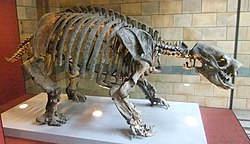
Kingdom: Animalia
Phylum: Chordata
Class: Mammalia
Order: Xenarthra
Family: Mylodontidae
Genus: Glossotherium
Species: G. robustum
G. chapadmalense
Temporal Range: Late Pliocene to Early Holocene (2.5 - 0.010 ma)
Its literal meaning is the Tongue Beast. It was a genus of ground sloth which was heavily built animal with a length of about 13 ft snout to tail-tip and a weight estimated at 1000 kg. They could potentially assume a slight bipedal stance.
They are generally wider and more robust with a dignostic increased amount of lateral flare at the predental spout.
G. robustum was endemic to South America and weighted about 1500 kg. Pleistocene records indicate that it was widely distributed between 20 degree south to 40 degree south with a range spanning across Argentina, Chile, Uruguay, and Paraguay.
Sloths have ever-growing adult dentition. They lack deciduous dentition and have a reduction in tooth number. Sloth teeth also lack the enamel and cuspation pattern generally present in other mammals. Their tooth forms are oval, sub-rectangular or elongate irregular ovoid. cheek teeth in Glossotherium are larger, have more complex shapes and retain more of the cementum layer around all sides of each tooth than the shasta ground sloth and tree sloths.

Their diet is still unclear. However based on the dental evidence, it was likely more suited to grazing, though it was also probably less efficient at ingesting grasses since its dental apparatus was more suited to shearing which would have been too ineffective at processing plant materials down to an ingestible size to obtain adequate nutritive value. They have a very slow rate of passage of food through the gut. They could probably survive better on foods of lower nutritional value than other sloths could. They likely ate grasses, but also probably they ate a variety of foliage as well and would be better considered a browser-grazer than simple grazer.
They use the same way what the elephants do to communicate. sloths may have used low frequency sounds in melting calls or other social interactions of for long-range sound sensing as in predator-prey interactions or weather forecasting. Another possible explanation for hearing in low frequencies may be due to forssorial habits: low hearing frequencies coupled with a short interaural distance suggest that Glossotherium probably had very poor sound localization.This indicates evidence of an underground lifestyle since loss of high frequency hearing is common to fossorial mammals. Their huge nostrils were likely effective for sound emission with expanded nares possibly related to emission of low frequency sounds up to 600 Hz.
Due to its size and strength, Glossotherium would have had few natural enimies apart from Smilodon. It is believed to have died out in the Pleistocene (1.8 - 12,000 years ago). The most recent reported date is about 8700 years ago.
They have been found in South America and Mexico. It is closely related to Paramylodon of North America.Earliest Glossotherium specimens are known from the Pliocene of South America and are represented by the species, G. chapadmalense. All speciemens of Pleistocene age are typically lumped into G. robustum and a few other quentionalbe species. Further research is needed at the species level.

No comments:
Post a Comment